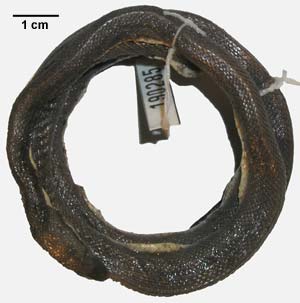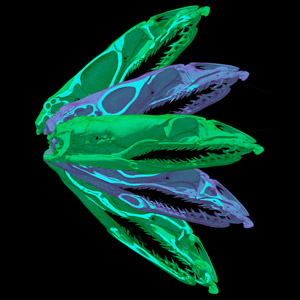Literature
Anthony J, Guibé J. 1951. Casarea, forme de passage entre les Boide´s et les serpents protéroglyphes. C R Acad Sci 233:203–204.
Anthony J, Guibé J. 1952. Les affinities anatomiques de Bolyeria et de Casarea (Boidés). Mém Inst Sci Madagascar Sér A 7:189–201.
Apesteguia S, Zaher H. 2006. A cretaceous terrestrial snake with robust hindlimbs and a sacrum. Nature 440:1037–1040.
Bellairs A d’A. 1949. Observations on the snout of Varanus, and a comparison with that of other lizards and snakes. J Anat 83:116–146.
Cundall D, Irish FJ. 1989. The function of the intramaxillary joint in the Round Island boa, Casarea dussumieri. J Zool 217:569–598.
Cundall D, Rossman DA. 1993. Cephalic anatomy of the rare Indonesian snake genus Anomochilus. Zool J Linnean Soc 109:235–273.
Cundall D, Wallach V, Rossman DA. 1993. The systematic relationships of the snake genus Anomochilus. Zool J Linnean Soc 109:275–299.
Frazzetta TH. 1966. Studies on the morphology and function of the skull in the Boidae (Serpentes), Part 2: Morphology and function of the jaw apparatus in Python sebae and Python molurus. J Morphol 118:217–296.
Frazzetta TH. 1970. From hopeful monsters to bolyerine snakes. Amer Nat 104:55–72.
Frazzetta TH. 1975. Complex Adaptations in Evolving Populations. Sunderland, MA: Sinauer. 267p.
Haas G. 1973. Muscles of the jaws and associated structures in the Rhynchocephalia and Squamata. In: Gans C, Parsons TS, editors. Biology of the Reptilia, Vol. 4. London: Academic Press. pp 285–490.
Haluska F, Alberch P. 1983. The cranial development of Elaphe obsoleta (Ophidia, Colubridae). J Morphol 178:37–55.
Hoffstetter R. 1946. Remarques sur la classification des ophidiens et particulièrement des Boidae des Mascareigns
(Bolyerinae subfam. Nov.). Bull Mus Natl d’Histoire Nat Ser 2 18:132–135.
Hoffstetter R. 1960. Sur la classification des boidés de Madagascar et de Mascareignes. Bull Mus Natl d’Histoire Nat 32:131–138.
Irish FJ. 1989. The role of heterochrony in the origin of a novel bauplan: Evolution of the ophidian skull. Geobios Mém Spec 12:227–233.
Irish FJ, Alberch P. 1989. Heterochrony in the evolution of bolyeriid snakes. Fortschr Zool 35:205.
Lee MSY, Scanlon JD. 2002. Snake phylogeny based on osteology, soft anatomy and ecology. Biol Rev 77:333–401.
McDowell SB. 1987. Systematics. In: Seigel RA, Collins JT, Novak SS, editors. Snakes: Ecology and Evolutionary Biology. New York: Macmillan. pp 3–50.
Oelrich TM. 1956. The anatomy of the head of Ctenosaura pectinata (Iguanidae). Univ Mich Mus Zool Misc Pub 94:1–122.
Pregill GK. 1977. Axial myology of the Racer Coluber constrictor with emphasis on the neck region. Trans San Diego Soc Nat Hist 18:185–206.
Rage J-C. 1984. Serpentes. In: Wellnhofer P, editor. Handbuch der Paläoherpetologie, Teil 11. Stuttgart: G Fischer. pp 1–80.
Rieppel O. 1979. The evolution of the basicranium in the Henophidia (Reptilia, Serpentes). Zool J Linnean Soc 66:411–431.
Rieppel O. 1984. Miniaturization of the lizard skull: Its functional and evolutionary implications. In: Ferguson MWJ, editor. The Structure, Development and Evolution of Reptiles. Zoological Society of London Symposia 52. London: Academic Press. pp 503–520.
Rieppel O, Maisano JA. The skull of the rare Malaysian snake Anomochilus leonardi Smith, based on high-resolution X-ray computed tomography. Zool J Linnean Soc (in press).
Rieppel O, Zaher H. 2001. The development of the skull in Acrochordus granulatus (Schneider) (Reptilia: Serpentes), with special consideration of the otico-occipital complex. J Morphol 249:252–266.
Rieppel O, Kluge AG, Zaher H. 2002. Testing the phylogenetic relationships of the Pleistocene snake Wonambi naracoortensis Smith. J Vert Paleo 22:812–829.
Scanlon JD. 2006. Skull of the large non-macrostomatan snake Yurlunggur from the Australian Oligo-Miocene. Nature 439:839–842.
Schlegel H. 1837. Essai sur la physionomie des serpens. Partie Générale þ Partie Descriptive. La Haye: J Kips, J HZ & W P van Stockum. 857p.
Tchernov E, Rieppel O, Zaher H, Polcyn MJ, Jacobs LJ. 2000. A new fossil snake with limbs. Science 287:2010–2012.
Underwood G. 1976. A systematic analysis of boid snakes. In: Bellairs Ad’A, Cox CB, editors. Morphology and Biology of Reptiles. London: Academic Press. pp 151–175.
Vidal N, David P. 2004. New insights into the early history of snakes inferred from two nuclear genes. Mol Phylogenet Evol 31:783–787.
Vidal N, Hedges SB. 2004. Molecular evidence for a terrestrial origin of snakes. Proc R Soc Lond B (Suppl) 271:226–229.
Links
Casarea dussumieri page on EncylopÆdia Mauritiana












